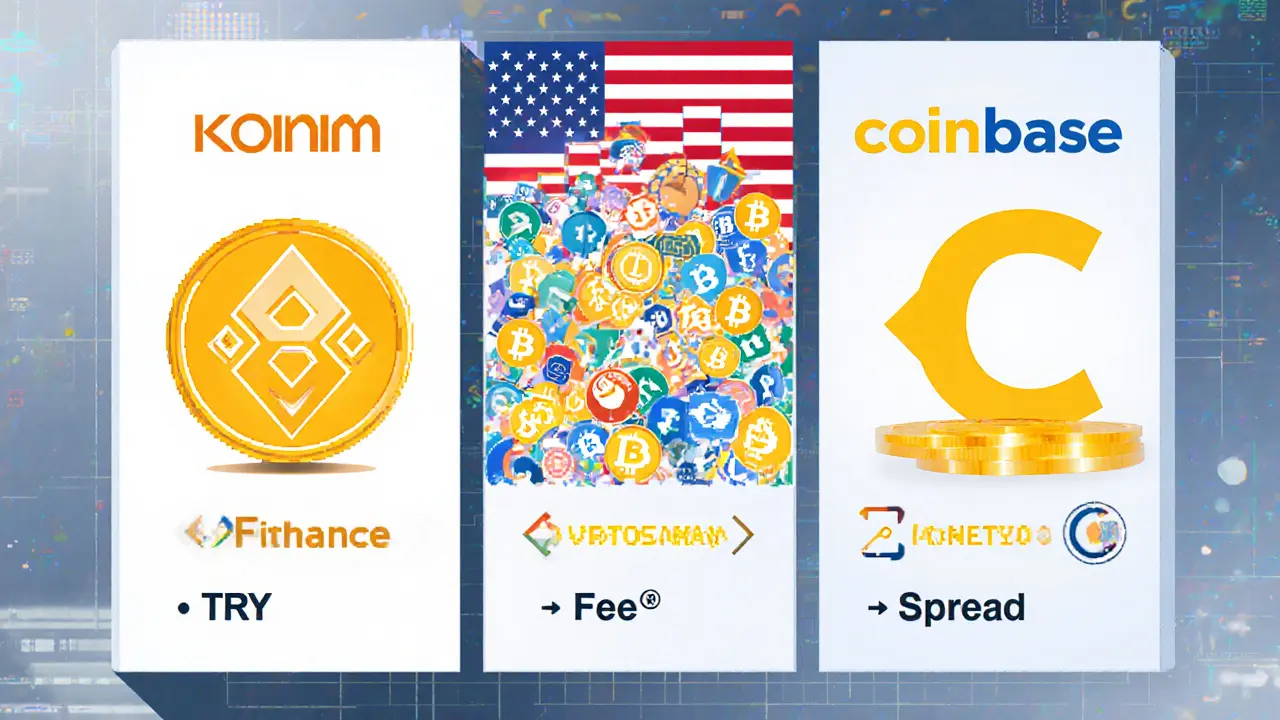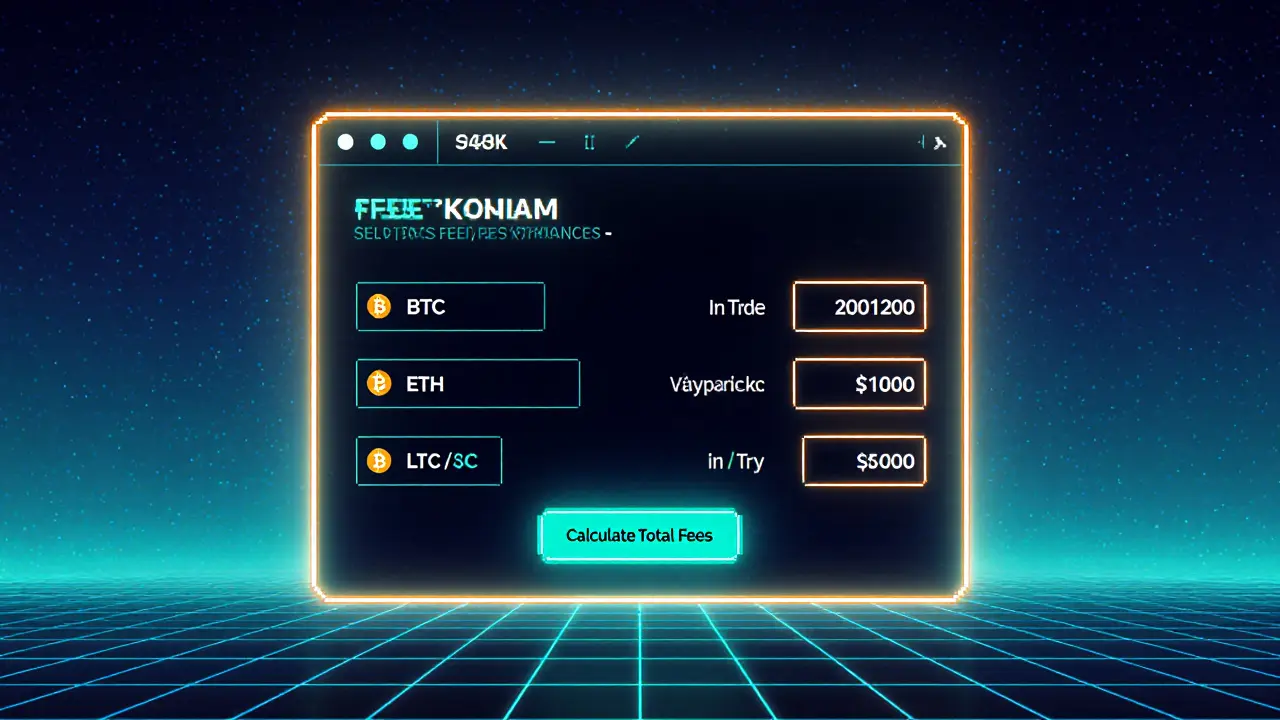Koinim Fee Calculator
Fee Breakdown
Enter values and click "Calculate Total Fees" to see results
Koinim vs Global Exchanges
| Feature | Koinim | Binance | Coinbase |
|---|---|---|---|
| Fiat Support | TRY only | USD, EUR, GBP, TRY, many more | USD, EUR, GBP, CAD, AUD |
| Cryptocurrencies | 7 | ≈600 | ≈250 |
| Leverage/Futures | No | Yes (up to 125×) | Yes (up to 10×) |
| Language | Turkish only | Multiple | Multiple |
| Regulatory Oversight | None specific | Multiple licenses | U.S. regulated |
| Typical Trading Fee | 0.2-0.3% flat | 0.01-0.1% tiered | 0.5-1.5% spread |
When it comes to trading crypto with the Turkish Lira, Koinim is a Turkey‑based exchange that has been operating since 2013, aiming to make crypto buying and selling simple for local users. It’s a niche platform, built for Turkish speakers, and it’s often compared with global giants like Binance or Coinbase. If you’re wondering whether Koinim fits your needs, this Koinim review breaks down the most important aspects - from fees to security, and everything in between.
TL;DR
- Koinim supports only 7 cryptocurrencies, with BTC/TRY and LTC/TRY as main pairs.
- Flat trading fees are modest, but withdrawal fees can be higher than on larger exchanges.
- All users must verify identity in Turkish; language barrier is a real hurdle for non‑Turkish speakers.
- Security relies on standard industry practices, but the platform lacks formal regulatory oversight.
- Best for Turkish residents who prefer a local interface; not ideal for global traders seeking variety.
What is Koinim?
Koinim was founded by Çagatay Yüksel in Istanbul and officially launched in April 2013. The exchange’s core promise is “crypto trading in Turkish Lira (TRY) made easy.” Unlike multinational platforms, Koinim’s entire UI and support are in Turkish, and every fiat transaction is settled in TRY.
Core Features and Supported Assets
The platform currently lists seven coins, but the two most liquid pairs are Bitcoin (BTC) and Litecoin (LTC) against the Turkish Lira. The other supported assets include Ethereum (ETH), Bitcoin Cash (BCH), Ripple (XRP), and a couple of smaller tokens.
All trading is spot‑only - there’s no margin, futures, or derivatives trading. Deposit methods are limited to Turkish bank transfers and debit cards; credit cards are not accepted. The exchange charges a flat fee on each trade, typically around 0.2‑0.3%, though exact numbers can vary by volume tier.
Fees and Withdrawal Costs
Koinim’s fee structure is straightforward: a flat percentage per trade and a fixed withdrawal fee per cryptocurrency. For example, withdrawing 0.001BTC might cost 0.00005BTC, while a Litecoin withdrawal could be around 0.01LTC. Compared with Binance (which offers tiered discounts for high‑volume traders) or Coinbase (which adds a spread on top of its fee), Koinim’s fees are competitive for Turkish users but feel steep for those who trade frequently.
Because the platform only accepts TRY, users also face conversion costs when moving funds to non‑Turkish wallets or exchanges. These hidden costs can add up, especially when the Turkish Lira fluctuates against major currencies.
Security and Regulatory Standing
From a technical standpoint, Koinim employs industry‑standard SSL encryption, two‑factor authentication (2FA) via Google Authenticator, and cold storage for the bulk of user funds. However, the exchange operates without a dedicated regulator overseeing its activities. Turkey’s crypto regulatory environment has been fluid, with periodic restrictions on crypto payments but a generally permissive stance on trading. This lack of formal oversight means users must rely on the exchange’s own security claims rather than external audits.
In a 2025 analysis by Wikibit, users cited “lack of regulatory authority oversight” as a primary concern. While the platform has not reported any major hacks, the absence of a clear supervisory body can affect trust, especially for larger investors.

Technical Architecture
The back‑end is built on the Django Python framework, with Celery handling asynchronous tasks and Angular powering parts of the front‑end. In 2023, development partner STX Next delivered performance upgrades that boosted daily capacity by 300%, allowing the exchange to support four times more concurrent sessions during peak market spikes.
These improvements demonstrate that, despite its niche focus, Koinim can scale technically when demand surges. However, the platform still lacks the advanced order‑type engine found on larger exchanges.
User Experience: Onboarding, Support, and Language
New users must complete full KYC verification before they can trade. The verification process involves uploading a national ID, proof of address, and a selfie - all steps are conducted in Turkish. For Turkish residents, this is a familiar routine; for anyone else, it’s a barrier.
Support is available 24/7 via live chat and email, and users frequently praise the quick response times. Yet, because all communication is in Turkish, non‑speakers are left to rely on third‑party translation tools.
The UI is clean and simple, designed for beginners. Navigation tabs are clearly labeled, and the “Buy/Sell” wizard walks users through each step. However, the limited number of trading pairs means experienced traders may quickly outgrow the platform.
How Koinim Stacks Up Against International Rivals
| Feature | Koinim | Binance | Coinbase |
|---|---|---|---|
| Fiat Support | TRY only | USD, EUR, GBP, TRY, many more | USD, EUR, GBP, CAD, AUD |
| Cryptocurrency Count | 7 | ≈600 | ≈250 |
| Leverage / Futures | No | Yes (up to 125×) | Yes (up to 10×) |
| Language | Turkish only | Multiple (English, Turkish, etc.) | Multiple (English, Spanish, etc.) |
| Regulatory Oversight | None specific | Multiple licenses (e.g., Malta, Singapore) | U.S. regulated (FinCEN, SEC) |
| Typical Trading Fee | 0.2‑0.3% flat | 0.01‑0.1% tiered | 0.5‑1.5% spread |
The table makes it clear: Koinim is a highly specialized local player. It shines for Turkish users who want a simple, low‑fee spot market, but it falls short on variety, leverage, and global regulatory confidence.
Pros and Cons - Who Should Use Koinim?
- Pros
- Native TRY support eliminates conversion hassles for Turkish residents.
- Simple UI suitable for beginners.
- 24/7 Turkish‑language support.
- Flat, transparent fee schedule.
- Cons
- Only 7 crypto assets - limited diversification.
- No margin, futures, or advanced order types.
- All documentation and support in Turkish; language barrier for outsiders.
- Lack of formal regulatory supervision.
If you are a Turkish citizen with a local bank account and you plan to trade only a handful of major coins, Koinim can be a convenient entry point. If you need a broad portfolio, leverage, or a platform that complies with EU/US regulations, you’ll likely look elsewhere.
Getting Started - Quick Checklist
- Ensure you have a Turkish bank account or debit card for TRY deposits.
- Visit the Koinim website and click “Kayıt Ol” (Sign Up).
- Complete the KYC form: upload national ID, proof of address, and a selfie. All fields are in Turkish.
- Verify your email and wait for the approval (usually within a few hours).
- Deposit TRY via bank transfer or supported debit card.
- Navigate to the “Al/Sat” (Buy/Sell) section and place your first BTC/TRY or LTC/TRY order.
- Enable two‑factor authentication for added security.
FAQ

Frequently Asked Questions
Is Koinim safe for large investments?
Koinim uses standard security measures like SSL, 2FA, and cold storage, but it lacks a dedicated regulatory supervisor. For modest amounts it’s fine, but for sizable holdings many traders prefer exchanges with audited custody solutions.
Can I trade on Koinim if I don’t speak Turkish?
All interface elements, KYC forms, and support channels are Turkish‑only. Non‑speakers can use browser translation tools, but the experience is cumbersome and may lead to mistakes.
What are the withdrawal limits?
Withdrawal limits depend on verification level. Fully verified accounts can withdraw up to 50BTC per day, with fixed network fees applied per coin.
Does Koinim offer any API for bots?
A basic public API exists for price data, but there is no documented private trading API, limiting automated strategies.
How does Koinim handle regulatory changes in Turkey?
The exchange adapts its policies as the Turkish government issues new guidelines. However, because it operates without a specific license, regulatory shifts can lead to sudden service interruptions.







VICKIE MALBRUE
November 5, 2024 AT 01:16Koinim seems like a solid option for Turkish traders especially if you only deal in TRY and want a simple flat fee.
Waynne Kilian
November 9, 2024 AT 16:30Its definitely worth takinng a closer look at the fee strucure, even if it might definetly not cater to everyone – the simplicity could be a blessing for some, but also a limitation for those who want more choices.
Naomi Snelling
November 14, 2024 AT 07:43Read between the lines and you’ll see that the lack of regulatory oversight might hide some hidden agenda. It makes you wonder who’s really pulling the strings behind the scenes.
Michael Wilkinson
November 18, 2024 AT 22:56I respect the platform’s focus but the flat 0.2‑0.3% fee feels steep compared to tiered models elsewhere.
Billy Krzemien
November 23, 2024 AT 14:10If you’re new to crypto in Turkey, start with small trades on Koinim to get comfortable with the interface before exploring larger volume tiers.
april harper
November 28, 2024 AT 05:23The review reads like a sigh of disappointment echoing through an empty market.
Clint Barnett
December 2, 2024 AT 20:36When you first glance at the Koinim fee table, the simplicity of a flat 0.2‑0.3% spread can feel like a breath of fresh air in a world saturated with tiered labyrinths. However, that very simplicity masks a deeper narrative about market accessibility for the everyday Turkish investor. The platform’s exclusive support for TRY means you bypass the hassle of currency conversion, a boon for those whose wallets are already denominated in lira. On the flip side, the limited crypto selection of just seven coins restricts diversification, forcing users to hop onto other exchanges for broader exposure. Liquidity can be another hidden variable; with fewer trading pairs, order books may be thinner, potentially leading to slippage on larger trades. Yet, the absence of leverage options translates to a lower risk profile, which aligns nicely with a conservative investment philosophy. From a regulatory standpoint, the lack of a specific overseer invites both freedom and uncertainty, a double‑edged sword for risk‑aware participants. If you compare Koinim’s flat fee to Binance’s tiered structure, you’ll notice that heavy traders could actually save a few basis points on Binance, but they must also grapple with complex fee calculations. Conversely, occasional traders who stick to low volumes will likely find Koinim’s model more transparent and easier to budget for. The withdrawal fees, listed in coin denominations, are fairly standard, though the BTC fee of 0.00005 can feel steep when crypto prices surge. Security-wise, the exchange’s reputation remains relatively quiet, which can be comforting for those who distrust flashy marketing. Customer support in Turkish only may alienate expats, but for native speakers it offers a culturally resonant experience. In terms of UI, the platform’s design is minimalist, allowing users to focus on the trade rather than getting lost in excessive widgets. Overall, Koinim serves as a niche gateway for Turkish users who prioritize simplicity over breadth, carving out its own modest niche in the crowded crypto landscape. Whether you choose to stay within its borders or venture out to global giants ultimately depends on how you balance convenience against opportunity.
Jacob Anderson
December 5, 2024 AT 04:10Oh great, another ode to fees-thanks for the poetry, I’ll just ignore the actual numbers now.
Kate Nicholls
December 7, 2024 AT 11:43While the prose is impressive, the practical takeaways about fee savings are a bit thin.
Carl Robertson
December 10, 2024 AT 23:03Seriously, Koinim is the ghost of crypto exchanges past, haunting any trader daring enough to think it’s relevant today.
Rajini N
December 13, 2024 AT 06:36What you need to watch is the volume tier thresholds; once you cross 10k TRY you’ll immediately see the fee dip to 0.25%, which can make a noticeable difference over time.
Sidharth Praveen
December 16, 2024 AT 17:56Give Koinim a shot if you’re just starting – the low barrier and flat fees can boost your confidence without draining your capital.
Sophie Sturdevant
December 19, 2024 AT 01:30From a liquidity provisioning standpoint, the platform’s shallow order depth may induce adverse selection risk, making it suboptimal for high‑frequency execution strategies.
emmanuel omari
December 22, 2024 AT 12:50Anyone who claims Koinim is superior ignores the fact that without proper licensing it cannot guarantee asset custodial safety, a fundamental requirement for any serious investor.
Andy Cox
December 24, 2024 AT 20:23Sounds decent for local trades.
Courtney Winq-Microblading
December 27, 2024 AT 03:56I hear you, Andy – the simplicity can be soothing, yet it also whispers a subtle reminder that sometimes the plainest tools hide the most intricate stories beneath their surface.